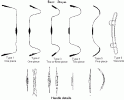- Joined
- Jan 24, 2001
- Messages
- 137
Hey Y'all,
As most of you know I recently got into forging and I have been itching to weld up my first billet of damascus. But I got some serious questions.
I just got about 18 ft of big bandsaw blade from one of them woodmizer sawmills. It is about 1 1/2 inches wide, but only about 1/16" thick. I am assuming that it is L-6, unless someone can tell me different. I heard this makes good contrast steel sandwiched with 10xx steel. I have 1084 and 1095, which would be better? Also the 10 series steel that I have is 1/8" thick, so should I go with 1 piece of the thinner saw blade between or put 2 in there to equal the thickness of the 10 steel? If I should make the thicknesses equal should I try to weld the pieces of bandsaw before I weld the rest of the billet or should I just put them together and weld all at once?
Also will 20 mule team borax work as flux if I heat it in the oven for a while to get all the water out?
If I have some extra kaowool, should I put a piece on the bottom of the forge to catch the flux so it don't eat my forge liner? Or maybe a hard firebrick in there?
On another subject here, has anyone here ever forged a steel bow? I like archery, and I read articles on this website called the Archer Antiquities. Recently I read an article about steel bows that were made in india. They have pics I could post or I could post a URL to the article if anyone wants. I was thinking about maybe trying to do one of these, sooner or later, and I was wondering how would you go about heat treating something like this?
Thanks in advance for any replies.
Chuck
As most of you know I recently got into forging and I have been itching to weld up my first billet of damascus. But I got some serious questions.
I just got about 18 ft of big bandsaw blade from one of them woodmizer sawmills. It is about 1 1/2 inches wide, but only about 1/16" thick. I am assuming that it is L-6, unless someone can tell me different. I heard this makes good contrast steel sandwiched with 10xx steel. I have 1084 and 1095, which would be better? Also the 10 series steel that I have is 1/8" thick, so should I go with 1 piece of the thinner saw blade between or put 2 in there to equal the thickness of the 10 steel? If I should make the thicknesses equal should I try to weld the pieces of bandsaw before I weld the rest of the billet or should I just put them together and weld all at once?
Also will 20 mule team borax work as flux if I heat it in the oven for a while to get all the water out?
If I have some extra kaowool, should I put a piece on the bottom of the forge to catch the flux so it don't eat my forge liner? Or maybe a hard firebrick in there?
On another subject here, has anyone here ever forged a steel bow? I like archery, and I read articles on this website called the Archer Antiquities. Recently I read an article about steel bows that were made in india. They have pics I could post or I could post a URL to the article if anyone wants. I was thinking about maybe trying to do one of these, sooner or later, and I was wondering how would you go about heat treating something like this?
Thanks in advance for any replies.
Chuck

